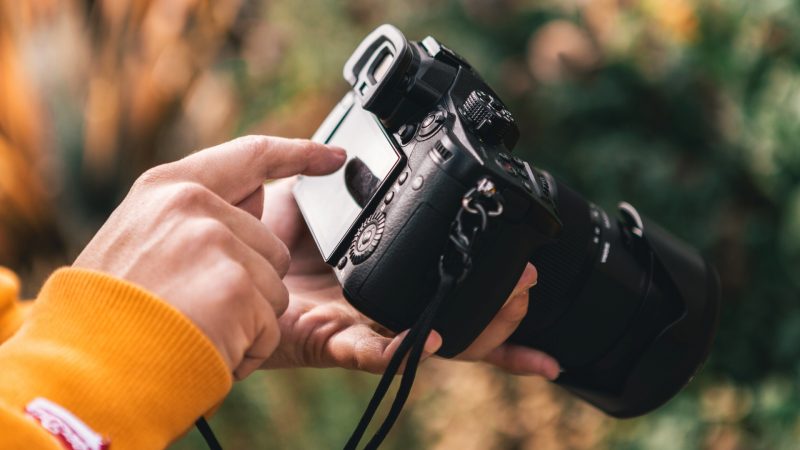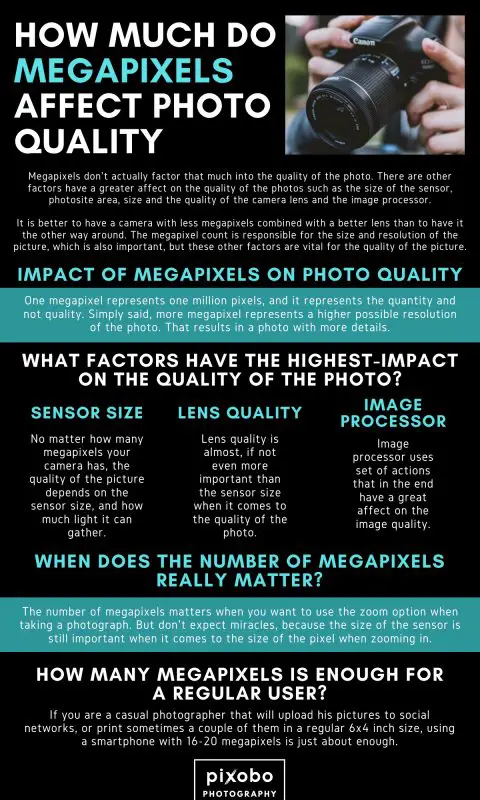Often regular users judge a camera’s quality by the sheer number of megapixels. It is not primarily their fault, because manufacturers put that information upfront like it is the only information you need.
That is a good selling point for manufacturers because with the technological advancements the cameras are having more and more megapixels, but is that characteristic that important when it comes to a pure quality of the photograph?
So, how much do megapixels affect photo quality? Megapixels don’t actually factor that much into the quality of the photo. There are other factors have a greater affect on the quality of the photos such as the size of the sensor, photosite area, size and the quality of the camera lens and the image processor. It is better to have a camera with less megapixels combined with a better lens than to have it the other way around. The megapixel count is responsible for the size and resolution of the picture, which is also important, but these other factors are vital for the quality of the picture.
Cameras that have up to the 24 MP have more than enough power to produce pictures with an amazing quality. We tested a lot of cameras, and we wanted to check is the number of megapixels really is that important when it comes to the pure quality of the photo.
Besides busting the myth of megapixels, we looked into other factors and their value when it comes to the quality of the picture. Of course, there are different types of photographers, not all have the same needs, so we also discussed these factors.
Some will benefit from a larger number of megapixels, and others not so much, but you can read all about it in the following sections below.
Table of Content
Impact Of Megapixels On Photo Quality

The number of megapixels is often shown as the main feature of the camera, in most cases, by the manufacturers themselves. Are they misleading customers by presenting megapixels as one of the main factors for the quality of the image? In short – yes.
So, how does the number of megapixels influence on the quality of the photograph? One megapixel represents one million pixels, and it represents the quantity and not quality. Simply said, more megapixel represents a higher possible resolution of the photo. That results in a photo with more details.
When do you need cameras with a large number of megapixels? When you want to print out a physical copy of the photo. Also, more megapixels offer higher digital zoom options without losing too much detail. Be aware that when you zoom in the picture, you will lose some amount of the details, and it will be even more visible on a printed copy.
Do two cameras with the same number of megapixels have the same quality of the photo? No, because sensor size is more relevant when it comes to picture quality. If you have a smartphone with a small sensor, it just can’t produce the same quality as the camera with a bigger sensor. Sensors are there to collect the light and that way every pixel is physically larger than in a smartphone with a small sensor.
There is one more thing to think about when using a camera with a large number of megapixels and that is – storage. Photographers that take a lot of pictures, with let’s say, the 40-megapixel camera will need large amounts of storage if they want to keep all of the pictures saved.
If you are a hobby photographer, that can be really expensive, and in the end pointless. You will rarely be able to actually see the benefit of a large number of megapixels on your photos. If you want to have some high-quality photos, you can always hire a professional to help you out.
What Factors Have the Highest Impact on the Quality of the Photo?

As we said earlier in the article, megapixels are only a small factor in the whole “quality of the photo” story. There are a lot more, and we will just point out a few that are really important:
Sensor Size
No matter how many megapixels your camera has, the quality of the picture depends on the sensor size, and how much light it can gather. A typical smartphone has a 1 / 2.5 inch or 1 / 1.8 sensor size, compared to some cameras that have 2 /3 inch or 4 / 3-inch sensors.
Larger sensor size leads to a larger photosite area that is responsible for collecting light while taking a picture. The more light is collected, the less the signal has to be amplified. What does that mean in human words? Well, your smartphone camera has a smaller sensor, and it will naturally collect less light than a full-size camera. With less light available, fewer data will be delivered to the image processor, resulting in a lower quality picture.
Larger photosite area results in a smaller impact of background noise on the quality of the photo. When we say “background noise” we are referring to noise generated by electronic devices, which is constantly there around us.
Lens Quality
Lens quality is almost, if not even more important than the sensor size when it comes to the quality of the photo. If you take a picture on some entry-level lens and some professional lens that costs as much as the camera and zoom in those pictures, you will easily see how much the lens quality affects the overall quality of the photo. Using a simple lens is completely different than using a multicoated DSLR lens.
Image Processor
Another important part of making high-quality pictures is an image processor. Its purpose is to first reproduce the shades of gray collected by the image sensor. An image processor is then adding colors (green, red and blue) pixel by pixel, following a pattern. Without an image processor, there would be just plain red, blue, and green pixels stacked one to another.
The processor is evaluating the color and brightness of every pixel and comparing it to its neighbors. Finally, it is using an algorithm to determine adequate values for the color and brightness of every single pixel. An image processor is also responsible for noise reduction by implementing ISO functions.
Finally, an image processor quality is determined by its ability to sharpens the edges and contours. That way the photo is preserving the feel of depth, clarity and fine details.
When Does The Number Of Megapixels Really Matter?
The number of megapixels matters when you want to use the zoom option when taking a photograph. But don’t expect miracles, because the size of the sensor is still important when it comes to the size of the pixel when zooming in.
Also, with a high megapixel camera, you can take a larger picture, and later, in editing, you can crop out some smaller part or detail you wanted to pay special attention to.
Another thing is the physical copy of the picture. With a camera, of let say, 12 megapixels, you can actually make a billboard.
How Many Megapixels Is Enough For A Regular User?
If you are a casual photographer that will upload his pictures to social networks, or print sometimes a couple of them in a regular 6×4 inch size, using a smartphone with 16-20 megapixels is just about enough.
The sensor size of smartphones is not big enough to support larger numbers of megapixels, so in the end, the quality of the larger photos will not be that good when cropped or zoomed in. If you are eager to produce some photos of the higher quality, don’t waste large sums of money on smartphones, and go for a regular size camera. They have larger sensors, better lenses and image processors from smartphones.
Also, if you want to really know how to make a quality photograph, you must learn how to use all the options made available to you. Even if you buy a high-end camera worth a couple of thousand dollars, it will not deliver its maximum if you don’t know how to use all of its advanced options.

Summary
When looking for a quality camera that can take quality photographs, there is a lot more to look for then a number of megapixels. Smartphone producers multiplied the numbers of megapixels in recent years and they are using that as the main marketing factor to lure in buyers.
Most of the users don’t go too deep when checking the actual information and facts and go for a most aggressive marketing campaign that depends on large numbers and figures, presenting them as the main factors in picture quality.
We have introduced you to actual facts. There are a lot more factors that impact the end quality of the photo, and guess what – it is not the number of megapixels.
You must keep an eye on those other factors that impact the sheer quality of the photo, like the size of the sensor, the quality of the lens, and the image processor unit. Those elements are crucial in collecting the light when taking the photo and converting it into an image with keeping as many details as possible.
If you want to take everyday photos and upload them on social networks, better smartphones will be enough for your needs, but if you are searching for something better, you should check for a quality full-size camera with a better lens and larger sensor. You will definitely see the difference.
If you want to continue reading about all the secrets of photography, keep an eye out for our blog, we will continue with articles like this!
